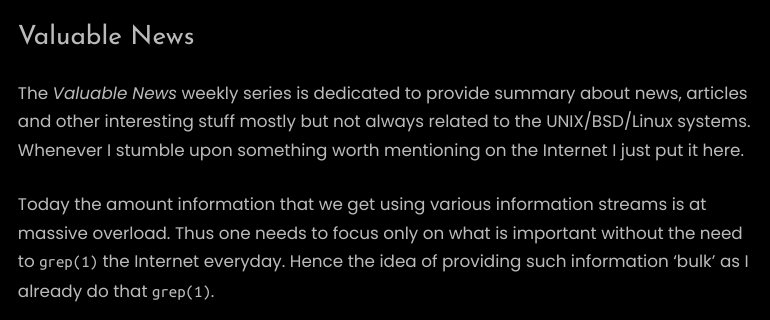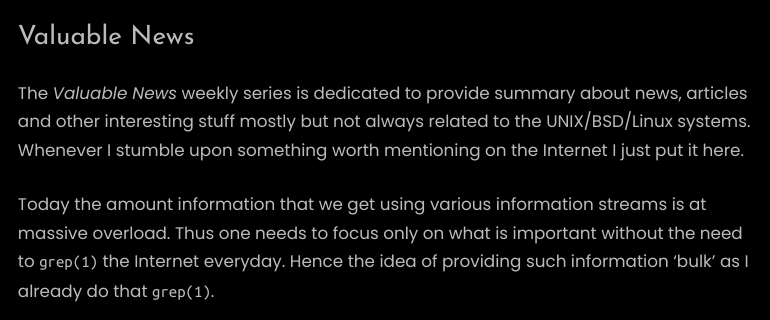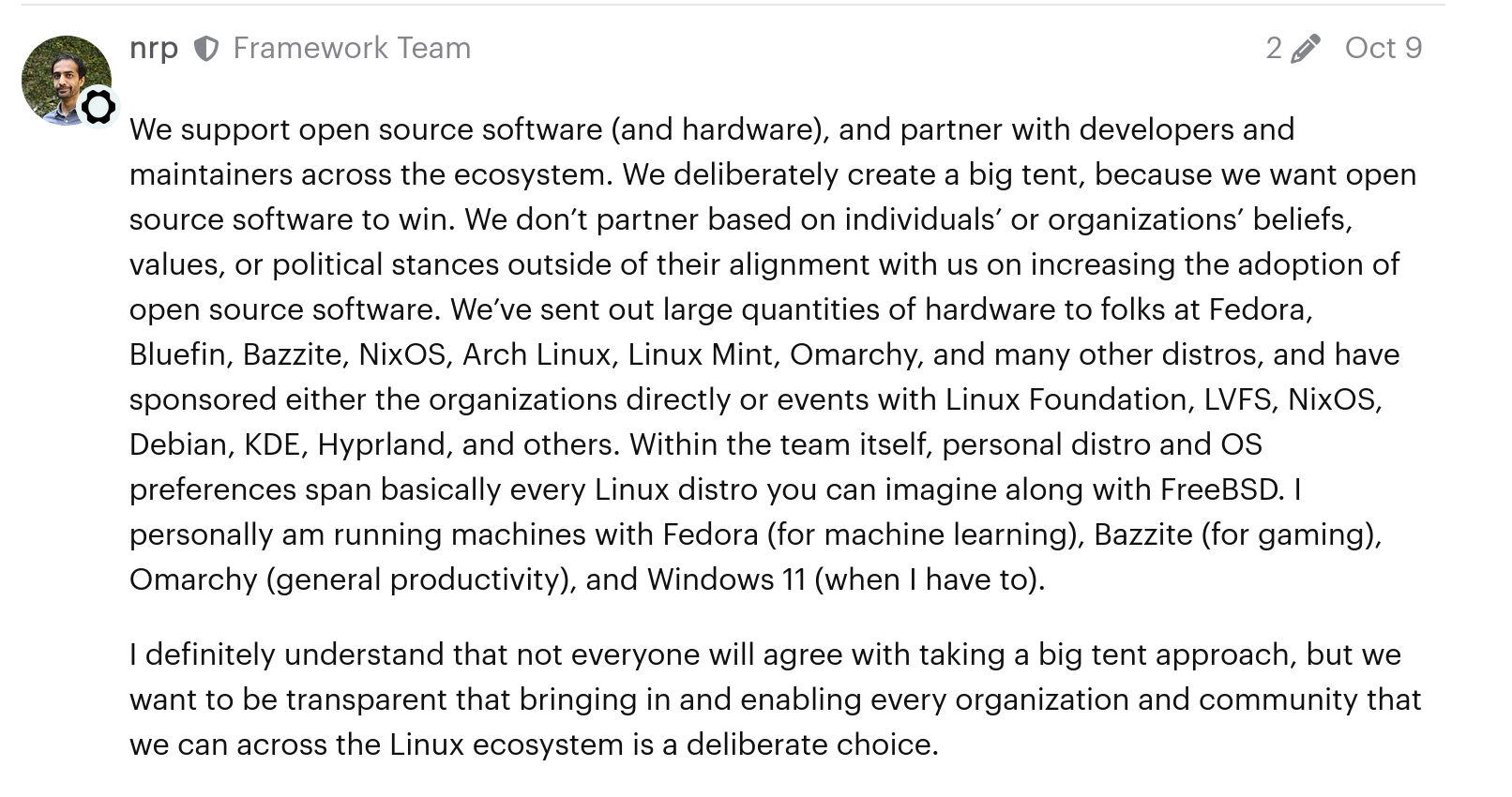Search results for tag #linux
Given the increased popularity of #Linux, I am pondering switching to #FreeBSD or #OpenBSD for all but my "main" computer (due to music making).
Should I? And what should I pick?
It's not a "linux is becoming bad" take, but I have always enjoyed using and supporting alternatives, and this will continue to be important for innovation, in the "non-capitalized version" of that word.
And just like that, we’ve hit 50% of our goal for the end of the year! 🎉
Have you joined #FriendsOfGNOME yet? If not, this is your sign to join 750 other amazing supporters:
If so, help us keep up the momentum by sharing with your friends, especially those outside of the typical contributor community. Let’s end the year strong!
#FriendsOfGNOME #GNOME #GNOMEFoundation #OpenSource #FOSS #Linux
We are launching an end-of-year fundraising campaign with a simple goal: to reach 1,500 Friends of GNOME. And we need your help!
https://blogs.gnome.org/foundation/2025/12/01/join-friends-of-gnome/
This week, we will also be sharing and celebrating the accomplishments of GNOME over the past year here on the fediverse; be sure to follow #FriendsOfGNOME!
Finally, if you’re already a Friend of GNOME or join this month, please join us in posting with #FriendsOfGNOME as well so that we can thank you. 😊
Latest 𝗩𝗮𝗹𝘂𝗮𝗯𝗹𝗲 𝗡𝗲𝘄𝘀 - 𝟮𝟬𝟮𝟱/𝟭𝟮/𝟬𝟭 (Valuable News - 2025/12/01) available.
https://vermaden.wordpress.com/2025/12/01/valuable-news-2025-12-01/
Past releases: https://vermaden.wordpress.com/news/
#verblog #vernews #news #bsd #freebsd #openbsd #netbsd #linux #unix #zfs #opnsense #ghostbsd #solaris #vermadenday
Latest 𝗩𝗮𝗹𝘂𝗮𝗯𝗹𝗲 𝗡𝗲𝘄𝘀 - 𝟮𝟬𝟮𝟱/𝟭𝟮/𝟬𝟭 (Valuable News - 2025/12/01) available.
https://vermaden.wordpress.com/2025/12/01/valuable-news-2025-12-01/
Past releases: https://vermaden.wordpress.com/news/
#verblog #vernews #news #bsd #freebsd #openbsd #netbsd #linux #unix #zfs #opnsense #ghostbsd #solaris #vermadenday
So, my #NovaCustom laptop arrived last week. I sadly have not had time to do the install until today. I'm going to work on it today and I'll post on this thread in case anyone is bored on a Sunday and wants to watch me struggle to install #Debian — having not installed it from scratch in nearly a decade.
This might be fun — if for no other reason than the lolz of an aging technologist struggling with installing a #Linux-based system.
You have my permission to laugh. Follow along today here.
What's the common wisdom regarding #Ubuntu #Linux and systemd-resolved, dnsmasq, and NetworkManager?
Had a weird thing happen where a #Wireguard tunnel didn't go up but DNS was still trying to connect to the DNS server over the WireGuard tunnel and was failing.
Is there any way to stop the DNS madness? It looks like they're both clobbering each other.
GNOME has had that system for more than two decades or so IIRC {if I recall correctly} they're 27 ATM.
I had seen it in the first couple of years of GNOME spawn and development, when the programmers chose the route of less configuration & more dictation
#sh #GNOME #reg #editor #OpenSource #programming #Linux #UI #Xorg #POSIX
FreeBSD 15.0 (almost)-RELEASE, using pkgbase, on my Ryzen 9 MiniPC (and compared to openSUSE Tumbleweed):
- Full disk encryption works beautifully via GELI, as usual.
- Installing KDE is easy and it works perfectly on Wayland.
- All my main apps work. Others will run via the Linuxulator or Wine (Linux browsers, WinBox for MikroTik, etc).
- The fan seems more relaxed.
- The system generally feels snappier.
- Native ZFS. I can autosnapshot every 5 minutes. If I try to do this with btrfs - snapshots of the home directory included and quotas enabled - the system hangs while handling them (which is why Tumbleweed doesn’t snapshot home by default).
- The media keys on my keyboard work, but volume control uses huge steps and 30 percent is already extremely loud. This can be fixed. The monitor brightness setting is also a bit off, but I don't care.
- amdgpu works perfectly.
- The wifi card works. I haven’t tested the speed because I immediately installed the realtek-re-kmod driver to use the 2.5 Gbit ethernet connection.
- Suspend doesn’t work. This is a big problem for me. It’s probably more psychological than technical, but I can’t leave the computer powered for hours when I’m not using it. I already have servers running 24/7 here. I even considered putting my Qotom FreeBSD server in a VM. It would probably work, but next summer it might be an issue because temperatures here aren’t low and spinning disks don’t love heat (and I don’t love their noise).
- It’s stable and reliable. I’ve done almost everything and it just works, as expected.
- Some small glitches remain, mostly due to missing configuration or packages (I didn’t tune anything. I just installed it and started using it).
A much smoother experience than a year ago, when I bought it.
Will I keep using FreeBSD on this minipc?
I’m not sure yet, since Tumbleweed works great and the lack of suspend really influences my choice. I'll contact Aymeric and try to offer some help to improve this.
For now, I’ll keep it on an external SSD and switch from time to time, especially when I know I’ll be using the minipc for hours.
Hyperlink Roundup 10! I'm proud I made it this far!
Several blogs and articles I've read since the last Hyperlink Roundup. Another good-bye to Firefox and some self-hosting media server posts.
Self-hosting is rising because Linux users refuse to wait for permission.
Two things that would've made my #Thinkpad x260 a perfect laptop:
- A little nicer screen (>1366x768, not TN (that's on me for not reading the ebay description more closely))
- A backlit keyboard, or heck, even a derpy ThinkLight XD
Otherwise, this is a pretty sweet bit of kit. 6th gen i5, 8GiB RAM, 256GB SSD, responsive keyboard, TouchPoint (ThinkNubbin) and touchpad, internal and external battery, roughly 6.5-8 hours battery life (I got 5:21:00 active usage yesterday and it only got down to 48% on the little internal battery (0% on the external) when I was done (it estimated 1:20:00 remaining)), super friendly to both #Linux and #BSD. Oh, and it's dirt cheap right now.
Hey is it still(?) correct that if I have a VM on a #Linux host that is connected by wifi, I can't bridge the network connection? Seems to be the consensus, and the evidence backs it up, but I'm hoping for a workaround.
My guest OS is Windows Server 2019, I'm using #QEMU and #virt-manager on #Arch.
#AskFedi #FediTechSupport
Forget the chaotic Black Friday sales! 🤯 NetBSD 🚩 offers the BEST deal: it's 100% FREE! Always has been, always will be. Perfect for self-hosters and anyone seeking pure, open-source goodness without spending a dime. No catches, just solid OS. #NetBSD #BlackFriday #FreeSoftware #SelfHost #RetroComputing #OpenSource #Linux #RunBSD
#POLL Results:
44 people are in deep denial about their existential dread, and should consult a counselor and read #Kierkegaard immediately 😁
139 people like teh pretty tings, and can't be bothered
188 people have started down the path towards enlightment
354 people are cool_kids
92 people are very_cool_kids
55 people laugh at your inadequate security model
27 people can run a server on a bit of bailing wire and a microcontroller from 1987 — fear them.
26 people are keeping Gassée's dream alive, and are plenny cool in my book
4 people are totally cool, and totally in a class by themselves
and 21 people kinda scare me, but I'd like to know more. 🤣
#humor #humour #houmor #houmour
#Windows #MacOS #Linux #CommandLine #BSD #RunBSD #FreeBSD #OpenBSD #NetBSD #Haiku #HaikuOS #BeOS #Amiga #Workbench #AROS #AmigaOS #Plan9 #9Front #TempleOS
P.S., wherever you find yourself, you're awesome. This is all for fun.
As part of our volunteer-driven accessibility initiative in GNOME Calendar, and for the first time in the 10+ years of Calendar's existence, we finally completed and merged the first step needed to have a working calendar app for people who rely on keyboard navigation. This merge request in particular makes the event widgets focusable with navigation keys (arrow left/up/right/down) and activatable with space/enter. This will be available in GNOME 49.
Most of GNOME Calendar's layout and widgets consist of custom widgets and complex calculations, both independently and according to other factors (window size, height and width of each cell, number of events, positioning, etc.), so these widgets need to be minimal to have as little overhead as possible. This means that these widgets also need to have the necessary accessibility features reimplemented or even rethought, including and starting with the event widgets.
We also hope to get other parts of GNOME Calendar accessible before GNOME 49, but I can't promise anything at the moment. We did start working with making the month view accessible: https://gitlab.gnome.org/GNOME/gnome-calendar/-/merge_requests/564
#GNOME #Calendar #GNOMECalendar #GTK4 #GTK #Libadwaita #Accessibility #a11y #Linux
Continuing our volunteer effort to make GNOME Calendar fully accessible with a keyboard (see thread for context), we fixed a major bug that was causing the focus to disappear into the abyss when the user tried to tab into the month view in merge request !576. This means, as of this commit, events should now be completely functional and accessible within the month view. Additionally, the merge request changes the keyboard and focus behavior within the month view: Events can only be cycled using arrow buttons, the focus can't escape the month view with arrow buttons, and entering/exiting the month view can only be done with tab. These improvements will be available on GNOME 49.
#GNOME #Accessibility #a11y #GNOMECalendar #Calendar #FOSS #FreeSoftware #Linux
After two weeks of writing, revising, and trying to make everything as digestible as possible, I finally published "GNOME Calendar: A New Era of Accessibility Achieved in 90 Days", where I explain in detail the steps we took to turn GNOME Calendar from an app that was literally unusable with a keyboard and screen reader to an app that is (finally) accessible to keyboard and screen reader users as of GNOME 49!
https://tesk.page/2025/07/25/gnome-calendar-a-new-era-of-accessibility-achieved-in-90-days/
#GNOMECalendar #GNOME #Accessibility #a11y #DisabilityPrideMonth #Linux #FOSS #OSS #OpenSource #FreeSoftware #GTK #libadwaita
@frameworkcomputer Framework's continued commitment to "deliberately create a big tent" is paying off.
More than a month since the last public statement comment from Framework on the subject and they still haven't distanced themselves from this guy.
The forum thread has over 2000 replies at this point..
https://community.frame.work/t/framework-supporting-far-right-racists/75986/
https://xcancel.com/dhh/status/1993747042213249448

 🍉
🍉 




![[?]](https://polymaths.social/fileserver/01HCMX6M1CZNEVJ4F5H58TT5XJ/attachment/original/01JHC5KM5K0V0J0436SPD3F86H.jpeg)


 🍵
🍵 



